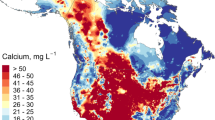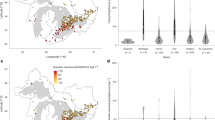Abstract
ACIDIFICATION of lakes and rivers accompanied by the loss of fish populations is a problem in Scandinavia1–4, northeastern USA5,6, and southeastern Ontario, Canada7,8. These areas have granitic or other siliceous bedrock types, thin and patchy podsolic soils, and extremely soft and poorly buffered surface waters, and receive precipitation which is decidedly acidic (volume-weighted average pH 4.0–4.6). Sulphate, whose principal source is precipitation, is usually the major anion in these acidified waters. In similar areas such as northern Scandinavia and northwestern Ontario, in which precipitation is not acidic (pH>5.0) such oligotrophic pristine softwaters generally have pH levels >5.5, and bicarbonate is the major anion9–11. Acidification of such waters entails a decrease in the bicarbonate buffer (alkalinity) with only minor decreases in pH, and then after exhaustion of the bicarbonate an increase in acidity to pH levels well below 5.0. Because of the severe damage to fish populations, and other biological consequences, the decreases in pH that characterise the later stages of the acidification process are of major concern. We need, therefore, a simple ‘early warning’ indicator that identifies lakes and rivers which are undergoing the first stage of acidification, the loss of alkalinity, but which have not yet reached the stage of marked pH decreases. Furthermore, we need quantitative estimates of the degree of acidification. We show here that excess sulphate concentrations, or current calcium concentrations and alkalinities can provide such an estimate.
This is a preview of subscription content, access via your institution
Access options
Subscribe to this journal
Receive 51 print issues and online access
$199.00 per year
only $3.90 per issue
Buy this article
- Purchase on Springer Link
- Instant access to full article PDF
Prices may be subject to local taxes which are calculated during checkout
Similar content being viewed by others
References
Gjessing, E. T., Henriksen, A., Johannessen, M. & Wright, R. F. SNSF-proj. FR 6/76, 64–85 (NISK, Ås, 1976).
Leivestad, H., Hendrey, G. R., Muniz, I. P. & Snekvik, E. SNSF-proj. FR6/76, 86–111 (NISK, Ås, 1976).
Odén, S. Water, Air, Soil Pollut. 6, 137–166 (1976).
Jensen, K. W. & Snekvik, E. Ambio 1, 223–225 (1972).
Likens, G. E. Chem. Engng News 56, 29–44 (1976).
Schofield, C. L. Ambio 5, 228–230 (1976).
Conroy, N., Hawley, K., Keller, W. & LaFrance, L. J. Great Lakes Res. 2, Suppl. 1, 146–165 (1976).
Beamish, R. J. & Harvey, H. H. J. Fish. Res. Board Can. 29, 1131–1143 (1972).
Wright, R. F. & Henriksen, A. Limnol. Oceanogr. 23, 487–498 (1978).
Almer, B., Dickson, W., Ekström, C. & Hörnström, E. in Sulfur in the Environment, part 2, (ed. Nriagu, J. O.) 272–311 (Wiley, New York, 1978).
Beamish, R. J., Blouw, L. M. & McFarlane, G. A. Tech. Rep. No. 607 (Dept of the Environment, Fisheries and Marine Services, Canada, 1976).
Bradford, G. R., Bair, F. L. & Hunsaker, V. Limnol. Oceanogr. 13, 526–530 (1968).
Likens, G. E., Bormann, F. H., Pierce, R. S., Eaton, J. S. & Johnson, N. M. Biogeochemistry of a Forested Ecosystem (Springer, Berlin, 1977).
Henriksen, A. Vann 7, 65–73 (1972).
Dillon, P. J., Yan, N. D., Scheider, W. A. & Conroy, N. Archs Hydrobiol. Ergeb. Limnol. (in the press).
Wright, R. F. et al. SNSF-proj. IR 33/77 (NISK, Ås, 1977).
Stumm, W. A. & Morgan, J. J. Aquatic Chemistry (Wiley, New York, 1970).
Wright, R. F. SNSF-proj. TN 34/77 (NISK, Ås, 1977).
Dovland, H., Joranger, E. & Semb, A. SNSF-proj. FR6/76, 15/35 (NISK, Ås, 1976).
Author information
Authors and Affiliations
Rights and permissions
About this article
Cite this article
HENRIKSEN, A. A simple approach for identifying and measuring acidification of freshwater. Nature 278, 542–545 (1979). https://doi.org/10.1038/278542a0
Received:
Accepted:
Published:
Issue Date:
DOI: https://doi.org/10.1038/278542a0
This article is cited by
-
Amphibian recovery after a decrease in acidic precipitation
Ambio (2018)
-
Acidic, neutral and alkaline forest ponds as a landscape element affecting the biodiversity of freshwater snails
The Science of Nature (2017)
-
Effects of aluminum toxicity induced by acid deposition on pine forest ecosystem in Longli of Guizhou Province, Southwestern China
Chinese Geographical Science (2016)
-
Long-term trends in water chemistry of acid-sensitive Swedish lakes show slow recovery from historic acidification
AMBIO (2014)
-
Thirty Years of Chemical Changes in Alpine Acid-Sensitive Lakes in the Alps
Water, Air, & Soil Pollution (2013)
Comments
By submitting a comment you agree to abide by our Terms and Community Guidelines. If you find something abusive or that does not comply with our terms or guidelines please flag it as inappropriate.



